Inbound marketing represents a paradigm shift in how businesses connect with their audience. Rather than overwhelming potential customers with aggressive advertising, this method focuses on drawing in an audience through valuable content and interactions that are tailored to their needs and stage in the buying cycle. It's a strategic, customer-centric approach that nurtures a relationship with the audience by providing them with the information they seek, when they seek it, thereby building trust and paving the way for a loyal customer base.
Introduction to Inbound Marketing
Inbound marketing is a holistic, data-driven approach that involves attracting customers to products and services via content marketing, social media marketing, search engine optimization, and branding. Unlike traditional marketing, which often interrupts the audience, inbound marketing engages a targeted audience in an ongoing conversation and nurtures them through the sales funnel. Here’s what sets it apart:
- Customer-Centric: It places the potential customer at the center of the marketing efforts, seeking to understand their challenges and needs.
- Content-Driven: Quality content is used to attract and engage visitors, providing value and establishing thought leadership in the industry.
- Multi-Channel: Inbound marketing operates across various channels to reach customers where they are, be it blogs, search engines, or social media platforms.
- Interactive: It encourages two-way communication through social media engagement, surveys, and feedback loops.
- Analytical: Data and analytics play a crucial role in understanding consumer behavior, refining strategies, and measuring success.
By focusing on these core elements, inbound marketing creates a foundation for attracting interested prospects, engaging with them on a deeper level, and ultimately delighting them with solutions that meet their needs and exceed their expectations.
Attracting Your Audience

The first phase in the inbound marketing methodology is to attract not just traffic, but the right traffic to your platforms. Here’s how you can attract your ideal audience:
- Identify Your Buyer Personas: Understand who your ideal customers are, what their pain points are, and what information they’re searching for online.
- Optimize for Search Engines: Implement search engine optimization (SEO) tactics to improve your visibility in search results for queries relevant to your business and content.
- Create Valuable Content: Produce high-quality blog posts, videos, infographics, and other content that provide answers and solutions to your audience's questions and needs.
- Leverage Social Media: Use social media platforms to share your content and engage with your audience, adapting your message for the nuances of each platform.
- Utilize Paid Advertising: Consider using targeted paid advertising like pay-per-click campaigns to drive traffic to your high-performing content.
By consistently applying these strategies, you can attract an audience that is more likely to become leads, customers, and eventually, promoters of your brand.
Engaging with Leads
Once you've attracted an audience, the next step is to engage with those leads to move them further down the funnel towards becoming customers. Engagement means providing potential customers with information and experiences that are relevant to their stage in the buyer's journey. Here’s how you can effectively engage with your leads:
- Personalized Communication: Use the information you have about your leads to send personalized messages that cater to their specific interests and needs.
- Marketing Automation: Implement marketing automation tools to nurture your leads by providing timely and helpful content based on their interactions with your brand.
- CRM Integration: Make sure your customer relationship management (CRM) system is integrated with your inbound marketing efforts to track leads' behavior and facilitate effective follow-up.
- Educational Content: Offer more in-depth content like ebooks, webinars, and whitepapers to educate your leads and position your brand as a thought leader.
- Interactive Tools: Use interactive tools like calculators, quizzes, or assessments to engage leads, providing them with valuable insights and personalized feedback.
Through these targeted and interactive engagement strategies, you can build a relationship with leads, provide them with value, and guide them towards making a purchasing decision.
Delighting Customers
Delighting customers involves going above and beyond their expectations to create an exceptional experience that fosters loyalty and encourages them to become promoters of your brand. Here’s how you can delight your customers:
- Exceptional Customer Service: Provide outstanding customer service that resolves issues quickly, exceeds expectations, and shows customers they are valued.
- Personalized Experiences: Tailor the customer experience by remembering individual preferences and providing personalized content, recommendations, and solutions.
- Feedback Channels: Open clear channels for customer feedback and show that you act on it, which demonstrates that you value their input and are committed to continuous improvement.
- Community Building: Create a community around your brand by leveraging forums, social media groups, or in-person events to connect customers with each other and with your brand.
- Surprise and Delight Tactics: Implement surprise elements like unexpected upgrades, gifts, or exclusive content that make customers feel special and appreciated.
By consistently delighting customers in these ways, you not only foster loyalty but also turn your customers into brand evangelists who are more likely to share their positive experiences with others.
Measuring Success in Inbound Marketing
To ensure that your inbound marketing efforts are effective, it's crucial to measure success and make data-driven decisions. Here’s a breakdown of key performance indicators (KPIs) and metrics to track:
- Traffic Metrics: Monitor the volume of visitors to your site and where they come from, such as organic search, social media, or referral links, to understand which channels are most effective.
- Conversion Rates: Track the percentage of visitors who take a desired action, like filling out a form or downloading content, to gauge the effectiveness of your engagement strategies.
- Lead Quality: Assess the quality of your leads by tracking how many turn into customers. This helps you refine your targeting and content strategy.
- Customer Acquisition Cost (CAC): Calculate the cost of acquiring a new customer to ensure that your inbound marketing efforts are cost-effective.
- Customer Lifetime Value (CLV): Determine the total value a customer brings over their lifetime to measure the long-term success of your customer retention strategies.
By regularly reviewing these metrics, you can identify strengths and weaknesses in your inbound marketing strategy, allowing for timely adjustments and optimization for better ROI.
Conclusion
Inbound marketing marks a transformative approach to building and nurturing relationships with customers. By attracting the right audience, engaging leads with relevant and personalized content, and delighting customers by exceeding expectations, businesses can foster a loyal customer base that not only believes in their product or service but also advocates for their brand. The key to successful inbound marketing lies in the synergy of these strategies and the continuous measurement of their effectiveness through data-driven insights. As technology and consumer behaviors evolve, so too must inbound marketing tactics, always with the goal of providing value and building trust. This customer-centric methodology does more than just sell; it creates an ecosystem of mutual benefit, where the success of the customers fuels the success of the business. In the end, the essence of inbound marketing is about creating meaningful connections that drive growth and sustain businesses in the long term.
You probably know that the speed of leads processing directly affects the conversion and customer loyalty. Do you want to receive real-time information about new orders from Facebook and Instagram in order to respond to them as quickly as possible? Use the SaveMyLeads online connector. Link your Facebook advertising account to the messenger so that employees receive notifications about new leads. Create an integration with the SMS service so that a welcome message is sent to each new customer. Adding leads to a CRM system, contacts to mailing lists, tasks to project management programs – all this and much more can be automated using SaveMyLeads. Set up integrations, get rid of routine operations and focus on the really important tasks.
